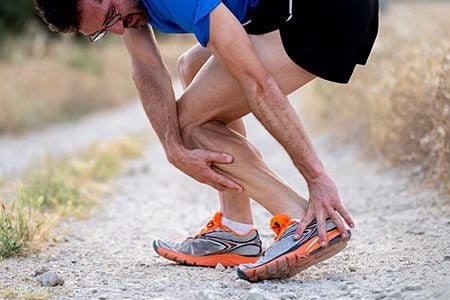
Sprains and strains are common conditions that cause damage to the soft tissues in the body such as the ligaments, muscles and tendons. In fact, approximately 2 million people in the U.S. have an ankle sprain each year. While these conditions have many similarities, they affect different parts of the body. A sprain refers to an overstretched, twisted or torn ligament (the tough fibrous tissue that connects the bones to other bones and cartilage). A strain, on the other hand, refers to an overstretched, twisted or torn tendon (the tough fibrous cord that connects muscles to bones) or a torn muscle. Strains are most common in the back, hamstring or shoulders, while sprains occur most frequently in the ankles, wrists, fingers and knees.
Causes and Symptoms of Sprains
Sprains tend to happen fast—often as a result of an injury to a joint. Common causes of injuries leading to sprains include walking or running on an uneven surface, sudden pivots or twists, using the hand or wrist to break a fall, contact sports injuries and playing racquet sports.
Sprains can be categorized as follows: In milder sprains, a ligament may be overstretched but not torn, with symptoms including swelling and soreness. In more troublesome sprains, a ligament can be partially torn, and symptoms may include prolonged pain and swelling. Weight may not be placed on this ligament, and there may be bleeding underneath the skin. In the most serious type of sprain, the entire ligament has been torn. There may have been a popping noise when the injury occurred, and there is likely to be severe pain, swelling and bruising. Weight may not be placed on this ligament—it is unable to function as it should and can restrict joint movement.
Causes and Symptoms of Strains
Strains may occur fast as a result of an injury (acute strains) or they may develop slowly over time (chronic strains). Common causes of acute strains include lifting heavy objects, jumping, throwing, running, and slip and fall accidents. Common causes of chronic strains include engaging in activities that require repetitive movements such as tennis, running, rowing and sitting or standing in an awkward position for an extended period of time.
Symptoms of strains include swelling, bruising, tenderness and pain. There may also be muscle spasms and cramps, muscle weakness and an impaired range of movement. Just as there are three grades of sprains, there are three grades of strains, ranging from an overstretched muscle or tendon to a complete tear.
Treatment for Sprains and Strains
Sprains and strains can often be healed at home on their own; however, a chiropractor can help reduce a person’s downtime and also help reduce pain while restoring flexibility and range of motion to the joint. Chiropractic treatment for sprains and strains may include manual manipulation to the affected region, soft tissue massage, stretching and special exercises, electronic muscle stimulation, laser therapy and/or hot or cold applications.
Why Seek Chiropractic Treatment for a Sprain or Strain?
A chiropractor will help to ensure that a strain or sprain heals properly and in a shorter amount of time. Studies have shown chiropractic care to be an effective treatment method for relieving the symptoms associated with sprains and strains. If you are experiencing symptoms of a sprain or strain, a chiropractor can help diagnose your condition. Upon your initial visit, your affected area will be examined. A chiropractor may order an imaging study or ultrasound to rule out a broken bone and determine the extent of any ligament, tendon or muscle damage. Upon diagnosis, your chiropractor will discuss your treatment options and help manage your recovery.
Sprains and strains can feel more serious than they are and can leave one unable to function normally for days to weeks at a time. If you suspect you have a strain or sprain, it’s important to get a diagnosis and start treatment. The sooner you begin, the earlier you will be able to get back to your normal activities.
